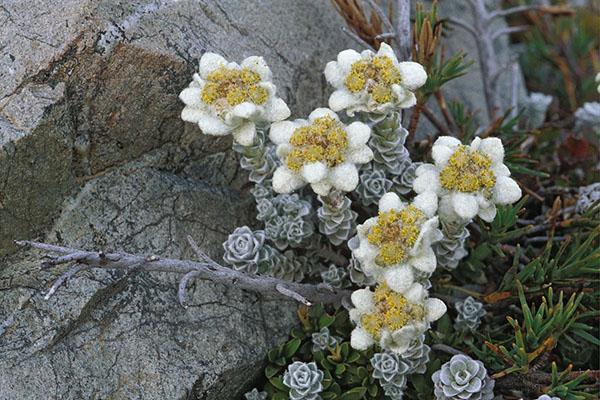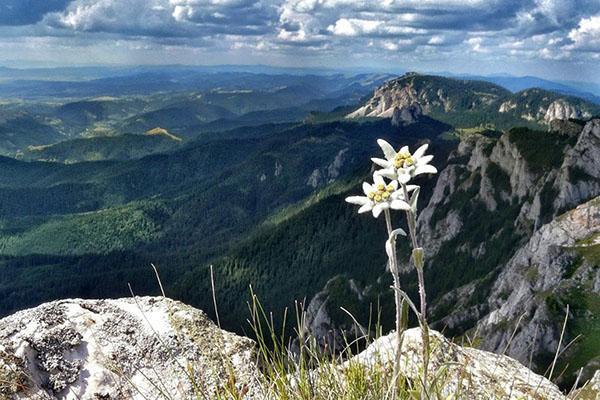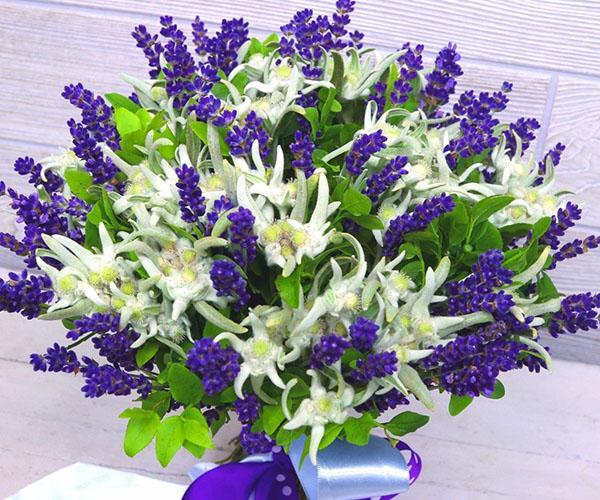Garden design: planting and caring for edelweiss
 Alpine star or edelweiss is a perennial plant that grows in mountainous areas on rocks, limestone beds, stone embankments. However, gardeners contrived to tame this amazing plant, so now planting and caring for edelweiss is not difficult even in the conditions of a summer cottage. It reaches a height of no more than 30 cm, has a special appearance that allows it to be easily distinguished from other representatives of the mountain flora.
Alpine star or edelweiss is a perennial plant that grows in mountainous areas on rocks, limestone beds, stone embankments. However, gardeners contrived to tame this amazing plant, so now planting and caring for edelweiss is not difficult even in the conditions of a summer cottage. It reaches a height of no more than 30 cm, has a special appearance that allows it to be easily distinguished from other representatives of the mountain flora.

Among the many varieties, gardeners recommend choosing leontopodium or alpine edelweiss, planting and caring for which will give results not only in the alpine and subalpine climate, but also in the climatic zone of central Russia.
Read also the article: lavender planting and care outdoors in Siberia!
Description
 The mountain edelweiss flower is modest and delicate, enchanting with its simplicity and shape. The inflorescences-baskets are colored yellow, their uncomplicated appearance is beautifully set off by pointed leaves. Having an unusual silvery color, they found the name of the Alpine stars. Their top is darker than the bottom side, which is densely covered with white felt. The silvery and white range of colors is appreciated by florists for its originality. They are happy to use fresh and dried edelweiss flowers in bouquets.
The mountain edelweiss flower is modest and delicate, enchanting with its simplicity and shape. The inflorescences-baskets are colored yellow, their uncomplicated appearance is beautifully set off by pointed leaves. Having an unusual silvery color, they found the name of the Alpine stars. Their top is darker than the bottom side, which is densely covered with white felt. The silvery and white range of colors is appreciated by florists for its originality. They are happy to use fresh and dried edelweiss flowers in bouquets.
Cut alpine stars retain their shape and color when dried. They can be safely used in herbariums and ikebans.
 In the flowerbed, flowers get along with neighbors, they do not clog them with their exuberant growth. However, they look best against the background of stones. They are recommended to be combined with the rock and conifers.
In the flowerbed, flowers get along with neighbors, they do not clog them with their exuberant growth. However, they look best against the background of stones. They are recommended to be combined with the rock and conifers.
Leontopodium in garden design
Landscaping gardeners appreciate the silvery leontopodium for its unusual coloration and actively combine it with other plants. For example, they look good next to him. aquilegia, border rose, alpine aster and violet. Breaking an alpine slide or a rock garden, they try to plant flowers between the stones. Thus, it seems that they grow directly on the stones. This effect is achieved only when the plants grow.
When landscaping a designer garden, it is imperative to take into account what conditions edelweiss requires, the agricultural technology of which is very different from the usual garden flowers.
Ways to use the alpine star in landscape design
Florists decorate gardens in different styles with a silvery plant: Japanese, fusion, eclectic, oriental, minimalism. Moreover, they use several planting methods:
- when working on creating a mixborder, the plant is used to fill the foreground, and is also planted between large boulders;

- for a rock garden, deciduous bushes with an extraordinary color, undersized juniper, as a creeping plant, shoots of edelweiss are taken, next to which lavender and mountain violet are placed;

- for rockeries, medium-sized conifers are selected (dwarf pine, western thuja), smaller ones are placed next to large stones, low shrubs (Kuril tea, Japanese spirea) are planted next to conifers closer to the foreground, the edges of rockeries are filled with soil plants, placing them in groups (gentian, edelweiss, creeping thyme, subulate phlox and others).

The Leontopodium should not be placed next to bright, large flowers. Against their background, it fades and becomes almost invisible.
Agricultural techniques: planting and caring for edelweiss
 In order for a mountain flower to grow well in garden conditions, it is enough to observe several conditions:
In order for a mountain flower to grow well in garden conditions, it is enough to observe several conditions:
- Choose a sunny place, preferably on a slope, so that the multi-stage landscape compositions are clearly visible. In this case, all species will have enough sunlight (in the shade, the edelweiss will wither away).
- Prepare a light mail with a high concentration of lime. The flower will not grow on well-fertilized soil, but it will literally burn out from fresh humus.
- Provide good soil drainage. Stagnation of water in the roots leads to the death of the plant.
- To rejuvenate the leontopodium once every three to four years, otherwise it will become obsolete over time.
- When caring for leontopodium, you need to completely forget about using nitrogen, phosphoric and any other fertilizers;
- Cover the clearing with spruce branches or fallen leaves in a snowless winter, and remove the shelter in early spring.
If you are planting not your own grown seedlings, but purchased parts of an adult plant, while recently dug up, keep in mind that it must be planted immediately after purchase.
As soon as the clod of earth on the roots dries up, the specimen will die. If you wrap the roots in a bag to retain moisture, the leaves will rot. Therefore, if the plot needs to be overexposed in the apartment before going to the country house, it is better to plant it in a regular pot.
How to grow edelweiss from seeds
 In order to breed an alpine star in your country house, you do not have to go hiking in the mountains. It is enough to buy a bag of seeds in a flower shop. Please note that in the middle lane I recommend Alpine edelweiss, growing from the seeds of which gives good results.
In order to breed an alpine star in your country house, you do not have to go hiking in the mountains. It is enough to buy a bag of seeds in a flower shop. Please note that in the middle lane I recommend Alpine edelweiss, growing from the seeds of which gives good results.
The following technology is used for sowing seeds:
- Prepare a substrate from perlite, sand in a one to one ratio, adding two parts of a universal soil.
- A plastic not very shallow container is selected and filled with steamed soil.
- At the end of winter, the seeds are prepared for planting.
- To grow edelweiss from seeds, you first need to mix them with sand. This will make it easier to distribute small seeds in the soil.
- Then they are distributed over the surface of the soil, pressing with the palm of your hand, sprayed and covered with glass.
- It is better not to lift the glass before the first shoots appear. The moisture content can be monitored by the color of the soil and the perspiration on the inside of the glass.
- As soon as the sprouts have appeared above the soil surface, the glass is removed. The container is moved to a well-lit place. Water in moderation and wait until they reach a couple of centimeters in height.
 It is worth noting that before growing edelweiss from seeds, you need to be patient. Seedlings sprout for a rather long time, and between the time a small sprout appears and the plant reaches two centimeters, it may take several months.
It is worth noting that before growing edelweiss from seeds, you need to be patient. Seedlings sprout for a rather long time, and between the time a small sprout appears and the plant reaches two centimeters, it may take several months.
Seedling care
 When the planting with edelweiss seeds went well, that is, the seedlings appeared and began to grow, you need to wait until three or four real leaves appear on them. At this time, the seedlings can be transplanted into pots for growing or directly into open ground to a permanent place.
When the planting with edelweiss seeds went well, that is, the seedlings appeared and began to grow, you need to wait until three or four real leaves appear on them. At this time, the seedlings can be transplanted into pots for growing or directly into open ground to a permanent place.
 When transplanting, it is important to take into account that the root system of the plant has developed well over a long period of growth. The roots are unusually long compared to the stem. They cannot be cut or twisted, then the flower will not grow well. It is necessary to prepare deep holes so that the roots can be straightened. Then they are covered with a dry lump of earth and squeezed with their hands. When all the specimens are planted, the flower bed is watered abundantly with water.
When transplanting, it is important to take into account that the root system of the plant has developed well over a long period of growth. The roots are unusually long compared to the stem. They cannot be cut or twisted, then the flower will not grow well. It is necessary to prepare deep holes so that the roots can be straightened. Then they are covered with a dry lump of earth and squeezed with their hands. When all the specimens are planted, the flower bed is watered abundantly with water.
The plant can sit still for a long time and not move into growth. It will be possible to understand that it has taken place when new side shoots appear.
How to keep flowers from aging
 During the period when edelweiss blooms, which have reached a year and a half, is considered their youth. It is a pity that after another couple of flowering they become mature and start to age. To protect them from this and keep them in the rock garden, you need to start the reproduction procedure by dividing.
During the period when edelweiss blooms, which have reached a year and a half, is considered their youth. It is a pity that after another couple of flowering they become mature and start to age. To protect them from this and keep them in the rock garden, you need to start the reproduction procedure by dividing. To do this, in early spring, the bush is dug up and divided into 10 or more parts. All parts can be planted by propagating the plant in this way. But after a few years, when the flower fills all the necessary places, you will have to get rid of unnecessary parts by sending them to compost or delighting your friends with exotic seedlings.
To do this, in early spring, the bush is dug up and divided into 10 or more parts. All parts can be planted by propagating the plant in this way. But after a few years, when the flower fills all the necessary places, you will have to get rid of unnecessary parts by sending them to compost or delighting your friends with exotic seedlings.
 Anti-aging is the key to good growth and a beautiful appearance. Edelweiss, planting and caring for (photo) which excludes the division of the bush, will begin to die in five years. After all, it does not grow over the area of the flower bed, and at the same time it practically strangles itself with roots.
Anti-aging is the key to good growth and a beautiful appearance. Edelweiss, planting and caring for (photo) which excludes the division of the bush, will begin to die in five years. After all, it does not grow over the area of the flower bed, and at the same time it practically strangles itself with roots.
Conclusion
 Planting and caring for edelweiss is a fun experiment. Having started it, you will not have time to look back how an ordinary summer cottage turns into a systematized landscape filled with design ideas. In total, adding stones, lavender and conifers to edelweiss gives an original mountain landscape.
Planting and caring for edelweiss is a fun experiment. Having started it, you will not have time to look back how an ordinary summer cottage turns into a systematized landscape filled with design ideas. In total, adding stones, lavender and conifers to edelweiss gives an original mountain landscape.
Read also the article: delphinium long-term planting and care!